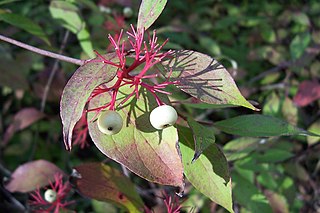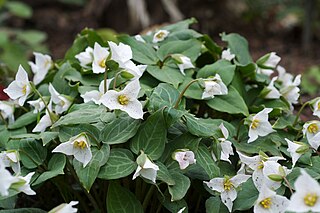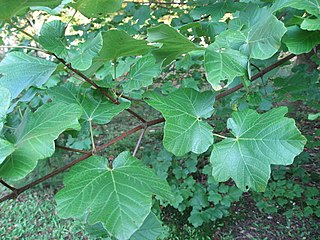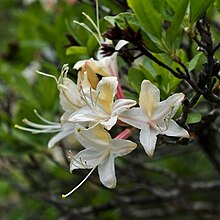
Rhododendron is a very large genus of about 1,024 species of woody plants in the heath family (Ericaceae). They can be either evergreen or deciduous. Most species are native to eastern Asia and the Himalayan region, but smaller numbers occur elsewhere in Asia, and in North America, Europe and Australia. It is the national flower of Nepal, the state flower of Washington and West Virginia in the United States, the state flower of Nagaland in India, the provincial flower of Jiangxi in China and the state tree of Sikkim and Uttarakhand in India. Most species have brightly colored flowers which bloom from late winter through to early summer.

Azaleas are flowering shrubs in the genus Rhododendron, particularly the former sections Tsutsusi (evergreen) and Pentanthera (deciduous). Azaleas bloom in the spring, their flowers often lasting several weeks. Shade tolerant, they prefer living near or under trees. They are part of the family Ericaceae.

Cornus sericea, the red osier or red-osier dogwood, is a species of flowering plant in the family Cornaceae, native to much of North America. It has sometimes been considered a synonym of the Asian species Cornus alba. Other names include red brush, red willow, redstem dogwood, redtwig dogwood, red-rood, American dogwood, creek dogwood, and western dogwood.

Pseudotrillium is a monotypic genus of flowering plant in the family Melanthiaceae. Its sole species, Pseudotrillium rivale, is commonly known as the brook wakerobin. It is endemic to the Siskiyou Mountains of southern Oregon and northern California. The Latin specific epithet rivale means “growing by streams”, with reference to a preferred habitat.

Acer opalus, the Italian maple, is a species of maple native to the hills and mountains of southern and western Europe, from Italy to Spain and north to southern Germany, and also in northwest Africa in Morocco and Algeria.

Adiantum aleuticum, the western maidenhair fern or Aleutian maidenhair, is a species of deciduous fern in the genus Adiantum.

Vaccinium uliginosum is a Eurasian and North American flowering plant in the genus Vaccinium within the heath family.

Trillium viridescens, also known as the Ozark trillium or tapertip wakerobin, is a species of flowering plant in the family Melanthiaceae. It is found in parts of Arkansas, Missouri, Oklahoma, Kansas, Texas and Louisiana. It usually grows in rich deciduous forests and mountain ranges where the soil is clayey and calcareous.

Rhododendron calendulaceum, the flame azalea, is a species of Rhododendron native to North America. All parts of this plant are poisonous to humans.

Rhododendron macrophyllum, the Pacific rhododendron, California rosebay, California rhododendron, coast rhododendron or big leaf rhododendron, is a large-leaved species of Rhododendron native to the Pacific Coast of North America. It is the state flower of Washington.

Acer crataegifolium , is a species of maple in the snakebark maple group, native to mountains forests of central and southern Japan, on Honshū, Kyūshū, and Shikoku.

The Great Balsam Mountains, or Balsam Mountains, are in the mountain region of western North Carolina, United States. The Great Balsams are a subrange of the Blue Ridge Mountains, which in turn are a part of the Appalachian Mountains. The most famous peak in the Great Balsam range is Cold Mountain, which is the centerpiece of author Charles Frazier's bestselling novel Cold Mountain.

Daphne bholua, the Nepalese paper plant, is a species of flowering shrub in the genus Daphne of the family Thymelaeaceae. It grows at altitudes of 1,700–3,500 m (5,577–11,483 ft) in the Himalayas and neighbouring mountain ranges, from Nepal to southern China. At lower altitudes it is found as an evergreen in thickets and forest margins; at higher altitudes, it is deciduous and is usually found in pastures and grassy glades. It usually reaches a height of about 2.5 m, though some specimens reach 4 m (13 ft) or more.

In the central and southern Appalachian Mountains of Eastern North America, a cove is a small valley between two ridge lines that is closed at one or both ends.

The Klamath Mountains ecoregion of Oregon and California lies inland and north of the Coast Range ecoregion, extending from the Umpqua River in the north to the Sacramento Valley in the south. It encompasses the highly dissected ridges, foothills, and valleys of the Klamath and Siskiyou Mountains. It corresponds to the Level III ecoregion designated by the Environmental Protection Agency and to the Klamath-Siskiyou forests ecoregion designated by the World Wide Fund for Nature.

Rhododendron arborescens, also known as smooth azalea or sweet azalea, is a species of flowering plant in the family Ericaceae, native to the eastern seaboard of the United States.
Buddleja candida is a small deciduous shrub widely distributed from north-east India through south east Xizang (Tibet) to the provinces of Sichuan and Yunnan in western China, growing on forest edges, in mountain thickets, and along riverbanks, at altitudes of 1000 – 2500 m. Named and described by Dunn in 1920, the shrub was introduced to cultivation in the west in 1928.

Buddleja macrostachya is a large deciduous shrub or small tree with a vast distribution, from Xizang (Tibet) through western China, Bhutan, Sikkim, northern India, Bangladesh, Myanmar (Burma), to Thailand and Vietnam, growing in scrub on mountain slopes to an altitude of 3,200 m, and along rivers in forests. The species was named and described by Wallich ex Bentham in 1835.

North American azaleas are flowering shrubs in the genus Rhododendron, section Pentanthera, subsection Pentanthera, so named because they all have five stamens. Most are in the United States, with one species found in Canada and one being found in Mexico. North American azaleas are commonly confused with azaleas of Asian origin, the evergreen azaleas. North American azaleas are deciduous and produce two types of buds. One is a larger and produces about 20 flowers while the other bud produces a leafy shoot. The flower color, fragrance, and number of stamens vary among species.

Acer distylum, the lime-leaved maple or linden leaved maple, is a species of flowering plant in the family Sapindaceae, native to north Honshu Island of Japan. Its closest relative is Acer nipponicum, with which it is grouped in the Acer section Parviflora. The species is noted for its 10–15 cm (4–6 in) unlobed leaves, the like of which are not found in any other maple species. The bark is grayish, and has a pink cast in young specimens. Acer distylum was first described by Philipp Franz von Siebold and Joseph Gerhard Zuccarini in 1845, and later brought to Europe by Charles Maries in 1879.


















